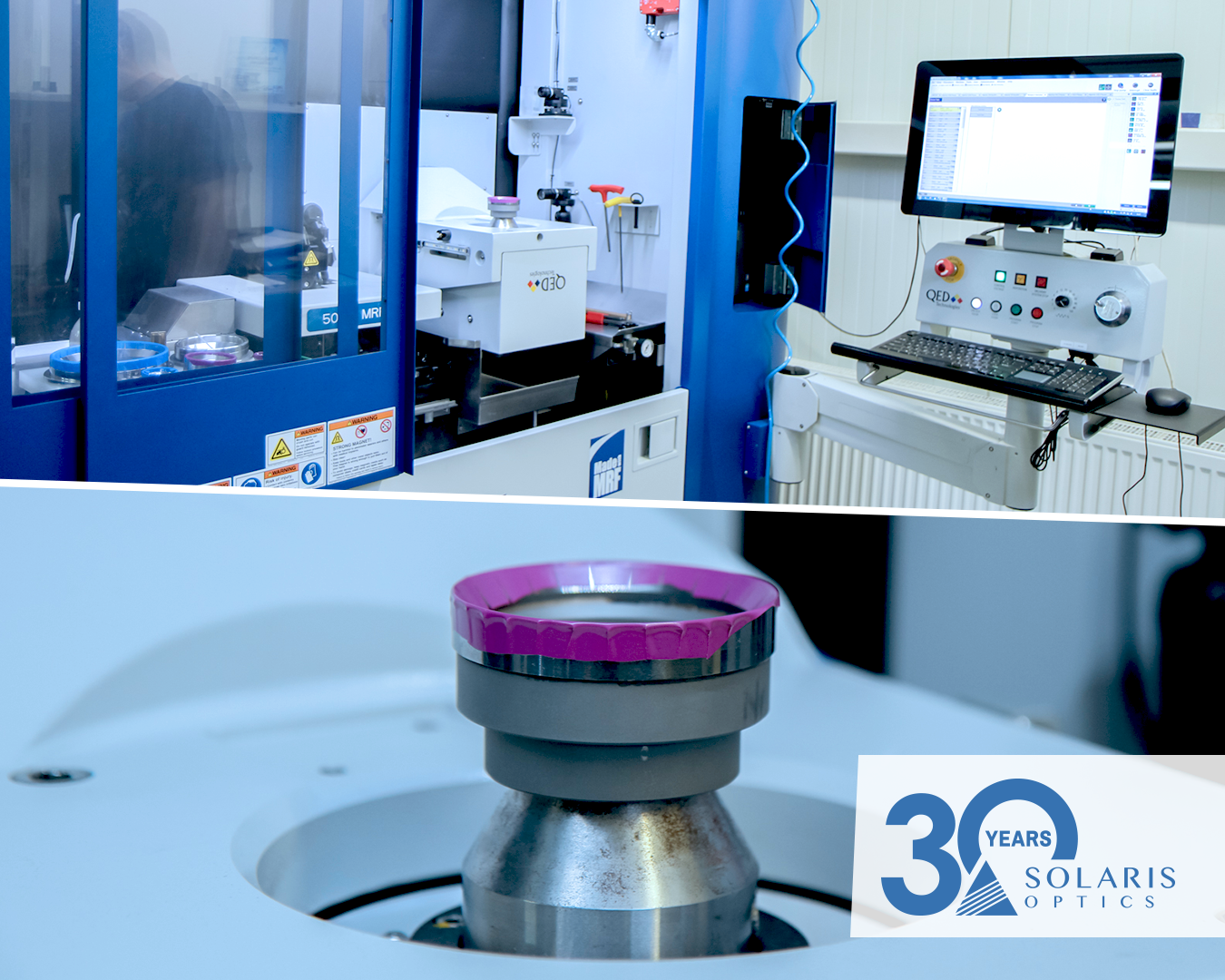Raster Mode to Expand Capabilities of Magneto-Rheological Finishing
Published: November 26, 2021
QED Q-flex 300 Magneto-Rheological Finishing (MRF) system has been used by Solaris Optics S.A. since 2015 and during this time proven to be able to produce optics with accuracy and precision unmatched by many competing technologies. The recent addition of a Raster Module is a further development towards higher precision of optical surfaces, by allowing to correct drawbacks of a rotational mode.
Magnetorheological polishing is a deterministic method for precise treatment of crystalline and glass optical surfaces which uses a fluid consisting of a polishing agent, magnetizable particles and stabilizing additives to perform material removal.
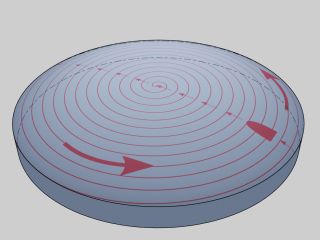
Figure 1 MRF Rotational Polishing Mode
The fluid is applied by a nozzle on a rotating wheel and a stable polishing ribbon is created on the surface of the tool by a magnetic field. The method is sub-aperture, meaning the polishing takes place only in the region where the tool contacts the workpiece surface. As such, the type of rotational path of the wheel relative to the workpiece has an impact on what geometries and shapes it is possible to polish.
MRF Raster Mode Explained
The unique strength of the magnetorheological effect is a perfect coupling with a computer control, which allows using complex algorithms to guide the position of the tool and the workpiece. QED MRF Q-flex 300 system offers two methods to determinate the path of the workpiece as it travels over the workpiece surface – a rotational and a raster path.
“The installed raster mode module will allow us to eliminate the undesirable central artifact effect that often occurs when working in rotational mode. This will largely translate into an improvement in the quality of our products, but will also expand the range of parameters achieved on optical surfaces during the corrective polishing process.”
Kamil Łęcki, Technical and Investment Manager at Solaris Optics
Solaris Optics initially installed a basic setup based on the Q-flex – the Rotational Mode which means the tool works the part following a rotational path. The method is suitable for polishing rotationally symmetric lenses, including plano, spheres and aspheres in diameters up to 300 mm. Nevertheless, responding to current trends and client demands, in 2021 Solaris Optics expanded the possibility of corrective polishing with the addition of the Q-flex Raster Module functionality. In this module the tool travels the part in the pre-determined raster path and removes a layer of material from flat and prism surfaces.
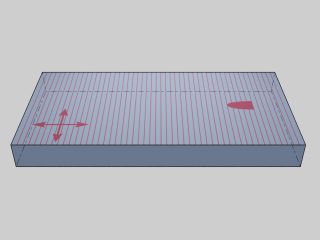
Figure 2 MRF Raster Polishing Mode
This investment, at first glance a minor change, introduces a new machine setup and a dedicated control software which guides the tool relatively to the workpiece along an equally spaced raster path. The technology overcomes limitations faced by traditional rotational methods and paves the way for more complex optical elements built with unique accuracy and minimal form deviation.
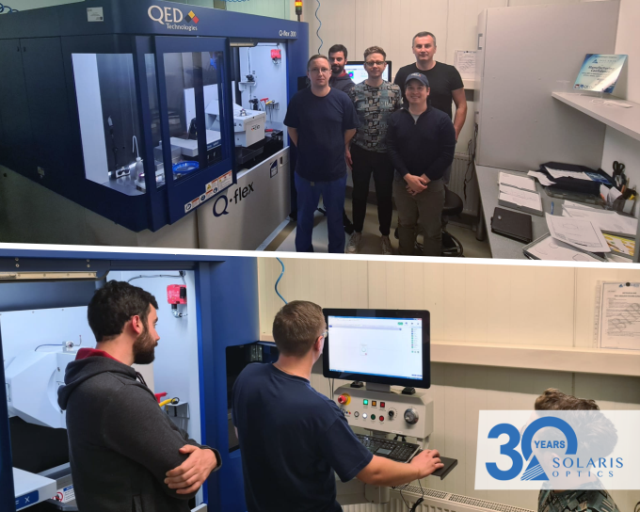
Figure 3 MRF Raster Mode Installation
New Manufacturing Capabilities
By operating the polishing head along the raster path rather than rotational as traditional manufacturing techniques, it opens doors to fabricate complex geometries while ensuring system’s performance and quality goals are met. Selective raster polishing of optical surfaces broadens the range of supported optical element types and allows for brand new functionalities such as prism figure correction. The supported apertures range from square, rectangular, hexagonal to elliptical. Apart from plano and spherical, the method is especially suitable for aspherics (including off-axis) and cylindrical optics within diameters up to 300 mm.
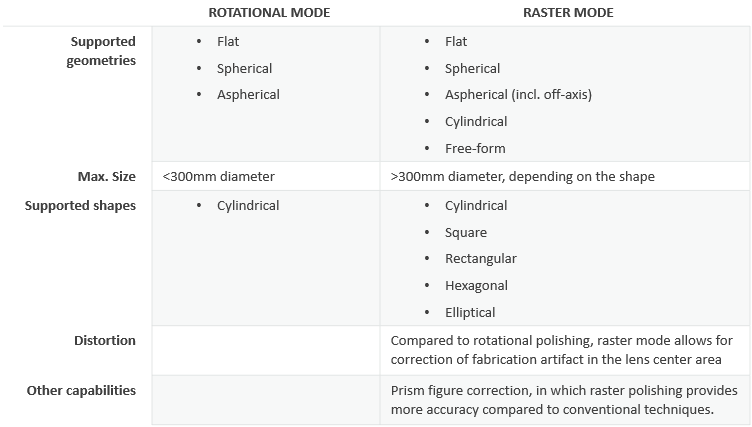
Figure 4 Rotational versus Raster Mode Overview
In all these cases, MRF produces high-quality surface characterized by micro-roughness of less than 1 nm rms and form irregularity that can reach levels as low as λ/30. Competing technologies struggle to deliver high-quality optics which are the backbone of many modern optical systems.
Complete System for New Applications in Optics
Magneto-rheological polishing stands out among fine finishing technologies as it enables fabrication of high-quality surface to extreme accuracy in a controlled, repeatable, and predictable manner. Due to integrated 3D metrology system, QED Q-flex 300 eliminates much of the manual work and additional processing steps. This deterministic process is known for speed and yield without sacrificing quality, making it a reliable and cost-effective method for producing precision optics. The introduction of Raster Mode has given Solaris Optics more flexibility to meet the increasing demand for high-end optics in areas including medical, military or life sciences.
***

